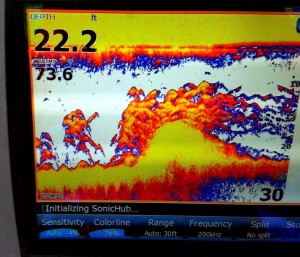 My goal in life is to be the kind of person my dog thinks I am. – The Bellamy Brothers
My goal in life is to be the kind of person my dog thinks I am. – The Bellamy Brothers
It’s easy to love a dog. On our worst days our dog still thinks we’re great. It doesn’t matter how badly we screw up, or how many catastrophes we’ve caused, in our dog’s eyes, we’re amazing. Most of the fishermen I know love dogs. Some of us take them fishing with us. Most dogs don’t care if we catch a fish or not, they’re just glad to be out on the water with us.
Crockett Lee wasn’t that kind of dog. Oh, he loved me unconditionally, but if I took him fishing and he didn’t see fish coming over the rail, he’d get mad. Real mad. I never wanted to take a skunk when Crockett was on the boat. If we got back to the dock without at least a white perch to show for our efforts, I could surely expect a severe bark-lashing. He made sure I knew I’d let him down. I think he finally got tired of my failures and took it upon himself to make me a better fisherman.
It started like this, when I moved from the Mountains to the Chesapeake Bay, my first fishing boat was a 25-foot long Sea Ray express cruiser. That boat wasn’t really designed for fishing, but I made a few angler-friendly modifications before naming her after my new Chesapeake Bay Retriever puppy and striking out to learn how to fish the Bay. Crockett grew up on Crockett’s Reel and always felt right at home there. When I got my center console a few years ago, Crockett would have none of it. He did not like Thunder Road. Gone were the comfortable carpeted floors that provided traction in rough water, and gone was the cushy upholstered seat that allowed him to sit up high and see over the rails. Read More!
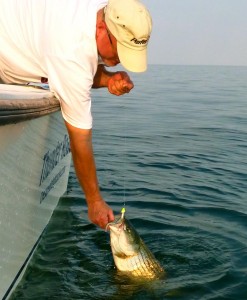 You’ve probably heard by now that the bottom is dropping out of striper fishing. The latest Atlantic States Fisheries Commission (ASMFC) stock assessment shows a population in decline. Don’t be fooled by the first few lines of the report when it says, “Stripers are not overfished and overfishing is not occurring.” They’ve been saying that for years while fishermen all up and down the Atlantic coast have been warning of a crash. Now we have proof. Using the current fishing mortality threshold, we have been overfishing for striped bass five out of the last eight years. If we keep catching at the rate we are now, the fishery will decline rapidly. Concerned fishermen up and down the Atlantic coast agree that harvest reductions should be implemented quickly. Check out this article from Captain John McMurray in New York.
You’ve probably heard by now that the bottom is dropping out of striper fishing. The latest Atlantic States Fisheries Commission (ASMFC) stock assessment shows a population in decline. Don’t be fooled by the first few lines of the report when it says, “Stripers are not overfished and overfishing is not occurring.” They’ve been saying that for years while fishermen all up and down the Atlantic coast have been warning of a crash. Now we have proof. Using the current fishing mortality threshold, we have been overfishing for striped bass five out of the last eight years. If we keep catching at the rate we are now, the fishery will decline rapidly. Concerned fishermen up and down the Atlantic coast agree that harvest reductions should be implemented quickly. Check out this article from Captain John McMurray in New York.
Since striped bass is a highly-sought-after species with big money involved on both the commercial and recreational sides, any reductions will be controversial. I get the sense that there may be some within the ASMFC who believe that the commercial striped bass fishing industry has already sacrificed enough. If that perception spreads, recreational fishing could take the brunt of the reductions. I won’t flesh out the arguments pro and con here, but suffice it to say that I believe cuts are overdue and necessary and should be equal across both sectors.
Commercial fishing aside, disagreements are sure to follow within the recreational community. They will be especially apparent here in the Chesapeake Bay, where the charter boat industry and some fishing clubs rely heavily on fishing revenues from spawning-class stripers during times of the year when they are easiest to catch. It’s sure to get interesting, and I expect blood letting on all sides. Read More!
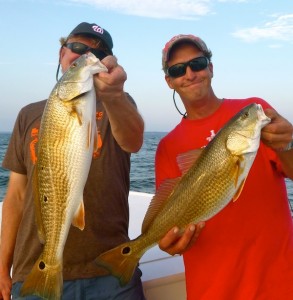 “If redfish keep biting like this, they can have the stripers!”
“If redfish keep biting like this, they can have the stripers!”
That’s a phrase I’ve heard more than once from Chesapeake Bay fishermen this year. I’ve been catching a few smallish reds around the Kent Island shoreline since May, but things have really opened up in the last week or so. Where are they and why are they here? I’ll tell you where later, but first let’s talk about why. Simply put, conservation measures are allowing red drum to expand their range. Successful fishing for slot-size red drum (fish between 18- and 27-inches long) is completely dependent on the success of spawning over the past three years. There is quite a bit of variation in a redfish’s rate of growth. At one year old, redfish will range from 10- to 17-inches long, averaging 14 inches. At two years old, they will range from 18- to 24-inches long. At three years old, they will range from 20- to 28-inches long, weighing four to nine pounds. If the reds you’re catching are in the slot, chances are they’re from the 2010 or 2011 spawning class. By all accounts, those were good years. Here’s the rest of the story: Read More!
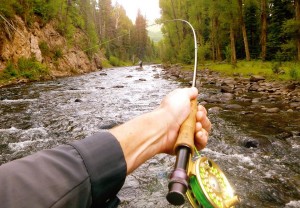 There’s nothing better for sharpening your light-tackle skills than scaling down and hitting the fast water in the creeks. Almost all I know about fishing I learned first in East Tennessee mountain streams. Tactics like swimming a lure with the current, casting to the deep side of cover, matching the hatch, looking for the dark water, minimizing terminal tackle, and the importance of stealth are all stream fishing techniques that translate easily to light tackle casting in the Chesapeake Bay. As much as I love the Bay and targeting the many species that live here, there are times when the call of the creeks is so great that I have to drop everything and go. Over the past couple of weeks, I’ve had a lot of fun stream fishing at some very scenic locations.
There’s nothing better for sharpening your light-tackle skills than scaling down and hitting the fast water in the creeks. Almost all I know about fishing I learned first in East Tennessee mountain streams. Tactics like swimming a lure with the current, casting to the deep side of cover, matching the hatch, looking for the dark water, minimizing terminal tackle, and the importance of stealth are all stream fishing techniques that translate easily to light tackle casting in the Chesapeake Bay. As much as I love the Bay and targeting the many species that live here, there are times when the call of the creeks is so great that I have to drop everything and go. Over the past couple of weeks, I’ve had a lot of fun stream fishing at some very scenic locations.
I’ve always had an interest in history and I’m especially intrigued by the Civil War. It’s not because of romantic notions about the ante-bellum South, but because it was such a seminal period for our country. I grew up kicking minie-balls around in the dirt near my farm in Mooresburg, Tennessee. Years later I was surprised to learn that the property I grew up on was the camp of General James Longstreet’s Army of Northern Virginia in the winter of 1863.  That led me to swinging a metal detector and turning up a nice collection of Confederate relics including some well-presevered belt plates, bullets, and buttons.
That led me to swinging a metal detector and turning up a nice collection of Confederate relics including some well-presevered belt plates, bullets, and buttons.
When I moved to Maryland, I visited several National Civil War Parks but I somehow missed the Antietam Battlefield near Sharpsburg. One of the most interesting stories from the killing fields of Sharpsburg is the battle of Burnside’s Bridge where 12,000 Federal troops were held at bay by 500 determined Georgians perched on the bluffs above the creek. Two weekends ago, I set off toward Antietam Creek to see if there are any fish below Burnside’s Bridge. Read More!
There’s nothing more exciting than drifting over an underwater hump and seeing the fishfinder light up with returns from big fish. I was a twinkle in my father’s eye in 1959 when Carl Lowrance and his sons revolutionized fishing with their Little Green Box. Things have changed a lot since then. There’s no doubt that a good fishfinder is an essential tool for successful fishing.
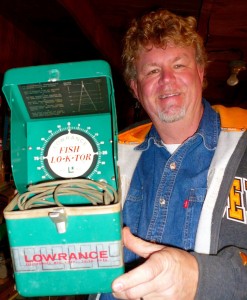 Just like with all fishing equipment there are many options to consider when it comes to choosing the right electronics for your angling arsenal. There’s been a lot written about the best units for off-shore fishing, and even more about fresh-water fishfinders, but I haven’t seen too much about the electronics that work best for light tackle fishing in the shallow, brackish waters of the Chesapeake Bay. Nothing beats experience in figuring out the essential bells and whistles of a good sonar unit. You can’t go wrong by hiring a guide and watching the way he or she uses her electronics. Since we’re in the business of shortening learning curves, here are ten tips to help you select the best light-tackle fishfinder for the Chesapeake Bay. Read More!
Just like with all fishing equipment there are many options to consider when it comes to choosing the right electronics for your angling arsenal. There’s been a lot written about the best units for off-shore fishing, and even more about fresh-water fishfinders, but I haven’t seen too much about the electronics that work best for light tackle fishing in the shallow, brackish waters of the Chesapeake Bay. Nothing beats experience in figuring out the essential bells and whistles of a good sonar unit. You can’t go wrong by hiring a guide and watching the way he or she uses her electronics. Since we’re in the business of shortening learning curves, here are ten tips to help you select the best light-tackle fishfinder for the Chesapeake Bay. Read More!
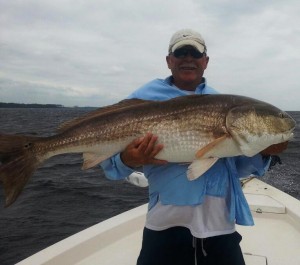 Hey, it’s summer and let’s face it, fishing is kind of mediocre. So, let’s have some fun! A very successful promotional campaign for a Mexican beer features a character called, “The Most Interesting Man In The World.” My choice for most interesting man in the world would have to be my regular fishing partner, Rich Jenkins. You’ve read some of my stories about his super-human exploits, and I can tell you a lot more over a cold drink or two. Surely, we all have someone we consider the most interesting man in the world, so I thought it would be interesting to jot down a few characteristics of the most interesting fisherMAN in the world. I thought of 30. Can you think of more?
Hey, it’s summer and let’s face it, fishing is kind of mediocre. So, let’s have some fun! A very successful promotional campaign for a Mexican beer features a character called, “The Most Interesting Man In The World.” My choice for most interesting man in the world would have to be my regular fishing partner, Rich Jenkins. You’ve read some of my stories about his super-human exploits, and I can tell you a lot more over a cold drink or two. Surely, we all have someone we consider the most interesting man in the world, so I thought it would be interesting to jot down a few characteristics of the most interesting fisherMAN in the world. I thought of 30. Can you think of more?
UPDATE: You can now follow The World’s Most Interesting Fisherman on Twitter. It’s @worldsfisherman or search #worldsmostinterestingfisherman. No, it’s not Rich Jenkins there, but it’s pretty darn funny!
1. Sharks have a week named after him.
2. Tidal currents stop and start moving again merely because he asks them to. Read More!



